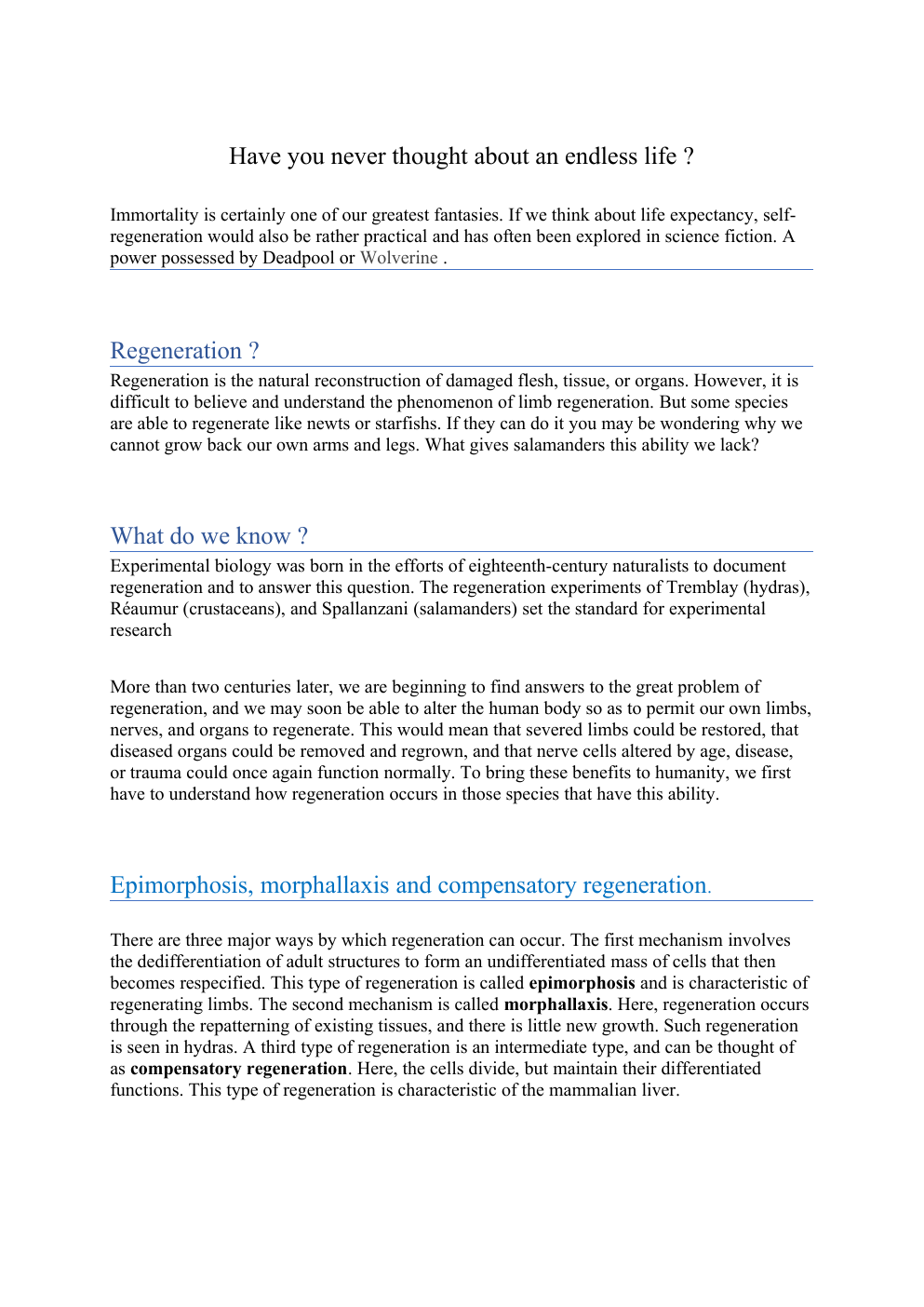Have you never thought about an endless life ?
Publié le 02/05/2024
Extrait du document
«
Have you never thought about an endless life ?
Immortality is certainly one of our greatest fantasies.
If we think about life expectancy, selfregeneration would also be rather practical and has often been explored in science fiction.
A
power possessed by Deadpool or Wolverine .
Regeneration ?
Regeneration is the natural reconstruction of damaged flesh, tissue, or organs.
However, it is
difficult to believe and understand the phenomenon of limb regeneration.
But some species
are able to regenerate like newts or starfishs.
If they can do it you may be wondering why we
cannot grow back our own arms and legs.
What gives salamanders this ability we lack?
What do we know ?
Experimental biology was born in the efforts of eighteenth-century naturalists to document
regeneration and to answer this question.
The regeneration experiments of Tremblay (hydras),
Réaumur (crustaceans), and Spallanzani (salamanders) set the standard for experimental
research
More than two centuries later, we are beginning to find answers to the great problem of
regeneration, and we may soon be able to alter the human body so as to permit our own limbs,
nerves, and organs to regenerate.
This would mean that severed limbs could be restored, that
diseased organs could be removed and regrown, and that nerve cells altered by age, disease,
or trauma could once again function normally.
To bring these benefits to humanity, we first
have to understand how regeneration occurs in those species that have this ability.
Epimorphosis, morphallaxis and compensatory regeneration.
There are three major ways by which regeneration can occur.
The first mechanism involves
the dedifferentiation of adult structures to form an undifferentiated mass of cells that then
becomes respecified.
This type of regeneration is called epimorphosis and is characteristic of
regenerating limbs.
The second mechanism is called morphallaxis.
Here, regeneration occurs
through the repatterning of existing tissues, and there is little new growth.
Such regeneration
is seen in hydras.
A third type of regeneration is an intermediate type, and can be thought of
as compensatory regeneration.
Here, the cells divide, but maintain their differentiated
functions.
This type of regeneration is characteristic of the mammalian liver.
Epimorphic Regeneration of the axolotl
A prime example is the axolotl (Ambystoma mexicanum), a species of aquatic salamander.
Unlike humans, it has the “superpower” of regenerating its limbs, spinal cord, heart, and other
organs.
When an axolotl’s limb is amputated, the remaining cells are able to reconstruct a
complete limb, with all its differentiated cells arranged in the proper order.
So an amputated
head from an axolotl can be transplanted on the body of another axolotl, yes it is weird but it
works.
In other words, the new cells construct only the missing structures and no more.
For
example, when a wrist is....
»
↓↓↓ APERÇU DU DOCUMENT ↓↓↓
Liens utiles
- It's a Wonderful Life It's a Wonderful Life, motion picture about a man who believes he is a failure because he never left the small town where he grew up, based on the story The Greatest Gift by Philip Van Doren Stern.
- confess, I've never thought too much about giving lessons.
- WHY I'M NOT WHERE YOU ARE 5/21/63 Your mother and I never talk about the past, that's a rule.
- Vocabulary about education life in the classroom: la vie de classe to
- MYTHS AND HEROES I'm going to talk you about the notion Myth and heros.





